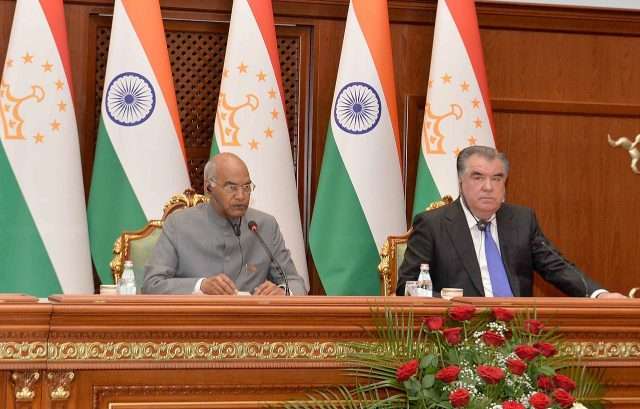
Geopolitical Report 2785-2598 Volume 12 Issue 12
Author: Silvia Boltuc
Since India seeks to strengthen its position and influence in Central Asia to counter China and Pakistan and Tajikistan needs to diversify its international partners, New Delhi – Dushanbe economic and diplomatic partnership might have a geopolitical effect on regional dynamics.
In an effort to balance China’s growing presence and Russian influence, Tajikistan seeks to diversify its international partners. In July, Indian External Affairs Minister Jaishankar, during his visit to Dushanbe for attending the SCO Foreign Ministers’ Summit, met Tajik President Rahmon and discussed security issues.
New Delhi, which aims to strengthen its position in Central Asia, has tripled its trade with Dushanbe in recent years, and the two countries have reached cooperation agreements in various sectors, such as education and tourism. Furthermore, they are both members of the Shanghai Cooperation Organization (SCO).
Tajikistan has recently increased its strategic role for the Indian policy in the region, given its border position with Afghanistan, where India has lost ground due to the sudden change in governance. New Delhi had close bilateral relations with the previous Afghan government and invested mainly in the country’s infrastructure. Furthermore, India was involved, along with Kabul, in regional transit corridors. The Taliban administration that took office in the country in August is hostile to New Delhi and risks spreading the conflict with Pakistan to the Kashmir region. In this context, military cooperation with Dushanbe could be a crucial strategic outcome.
There might be two strategic sites in which India can enhance its activity in strategic and military sectors: Ayni airbase (or Gissan military airfield – GMA) and Farkhor Air Base.
In 2007 India invested 70 million dollars in reconstructing the Soviet Union Ayni airbase, located 15 kilometres from Dushanbe, renting it for military use such as anti-terrorist operations and counter-Jihadist activities in Afghanistan. The possibility for India to carry out military operations in the Tajik base has long been discussed with Russia, being Moscow Dushanbe’s primary security provider.
In recent years, New Delhi had proposed the expansion of the base, underling its strategic importance, as confirmed this August, when the airbase allowed the expatriation of Indians fleeing Afghanistan.
Indian Air Force also run, together with Tajik Air Force, the Farkhor Air Base, 130 kilometres southeast of Dushanbe. New Delhi started operating the base in 2002 with Russian acquiescence. The airbase does not provide India with an alternative attack route against Pakistan or a logistic hub for operations against militants in Kashmir, not having active combat squadrons deployed there. Since the beginning, the base’s primary function was to transport India’s relief and reconstruction supplies into Afghanistan.
There are several reasons why India might be interested in more comprehensive cooperation with Tajikistan. First, to counter Pakistani military and commercial influence in the region. Pakistan represents the shortest route to the sea for Tajikistan, being the distance from the capital Dushanbe to the Pakistani port of Karachi 2720 km, while the Iranian port of Chabahar run by India is more than 3400 km away (Geopolitica del porto iraniano di Chabahar). On the other hand, Iranian-Tajik bilateral trade cooperation has grown. Tajikistan has repeatedly expressed its concern over Pakistan’s support to the Taliban and ISKP (Islamic State Khorasan Province), underlining that Indian-Iranian-Tajik collaboration might increase. In addition, Islamabad is planning a corridor with Afghanistan and Uzbekistan, cutting both Dushanbe and New Delhi off the trade lines.
Both India and Pakistan are trying to play a leading role in the central Asian market and its connections to Russia and Europe.
In addition, the Taliban plans to support Muslims in Indian-administered Kashmir. Military cooperation with Tajikistan might advantage India both to stabilise or intervene in this scenario and Afghanistan.
From a Pakistani point of view, Tajikistan is the closest gateway to Central Asia. Islamabad and Dushanbe are members of the Organization of Islamic Cooperation (OIC), SCO, the Economic Cooperation Organization (ECO), and the Heart of Asia – Istanbul Process.
Nevertheless, it must be underlined that Tajikistan is a member of the Collective Security Treaty Organisation (CSTO), along with Russia. Indian increasing alliance with the United States might concern Moscow and influence its willingness to allow Indian military presence in Tajikistan. As former U.S. Ambassador to the United Nations, Nikki Haley stated that the United States could rely only on India to counter Afghan extremists and China.
The alliance with the United States could represent a problem in Tajik-Indian relations since Tajikistan has repeatedly shown difficulties managing its foreign policy heavily influenced by Russia and China.
Conclusion
Tajikistan is part of Beijing’s Belt and Road Initiative. Furthermore, given the concerns surrounding the eastern Tajik area bordering Xinjiang, China has also military interests in the Central Asian republic. Beijing has stationed troops in the Gorno-Badakhshan area, within the Pamir Mountains area, on the border between the two countries and Afghanistan. The area is not far from the Wakhan corridor, a strategically important strip of Afghan land. In addition, China owns 53% of the Tajik foreign debt.
On the other hand, Tajikistan is becoming Moscow’s ‘outpost’ to avoid the rise of terrorist groups and contrast regional instability, becoming part of its buffer zone. Russia needs to control the security situation in Central Asia, where Moscow has always tried to promote its influence through the Eurasian Economic Union (EAEU) and Collective Security Treaty Organization (CSTO) (Tajikistan: the Kremlin’s frontier against the Taliban).



